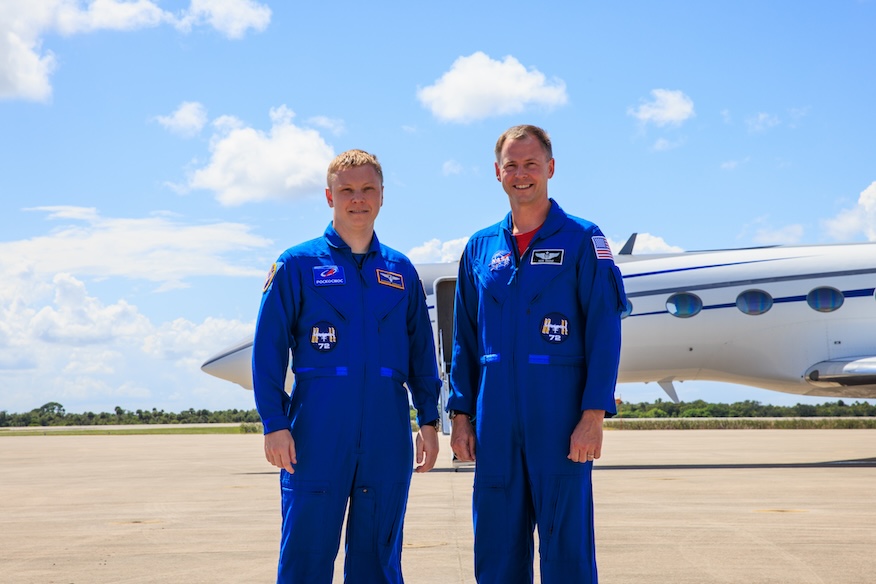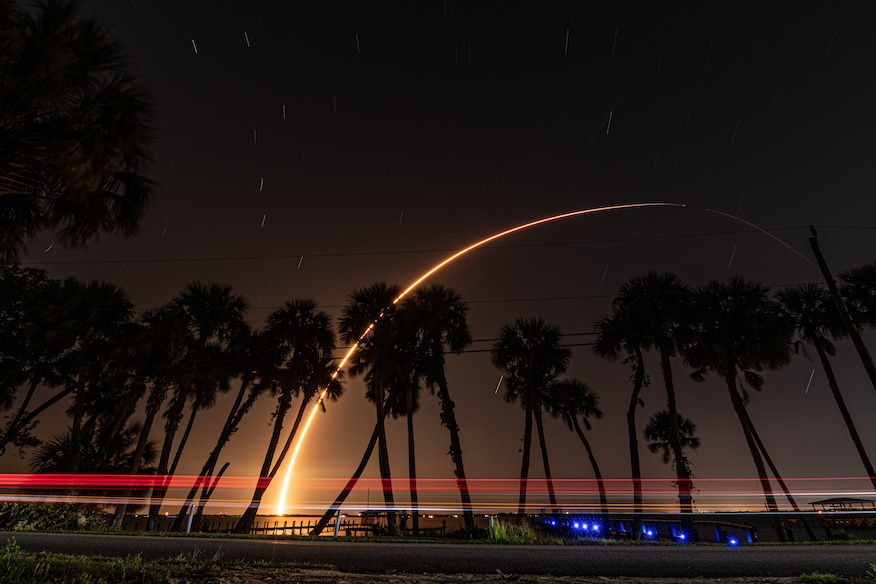
Update Sept. 23, 2:54 p.m.: NASA’s Kennedy Space Center shifted its status to HURCON 4, due to Potential Tropical Cyclone 9.
A crew scaled-back in the wake of this summer’s troubled Boeing Starliner test flight, arrived at the Kennedy Space Center this weekend to begin final preparations for their launch aboard a SpaceX Dragon on a six-month mission to the International Space Station.
NASA astronaut Nick Hague and Roscosmos cosmonaut Alexandr Gorbunov are set to launch to the orbiting outpost no earlier than Thursday, Sept. 26, at 2:05 p.m. EDT (1805 UTC). The mission will mark the first crewed flight from Space Launch Complex 40 (SLC-40) at Cape Canaveral Space Force Station.
On Monday, NASA, SpaceX and leadership with Space Launch Delta 45 were set to conduct a flight readiness review as they progress towards the planned launch date.
“Our NASA and SpaceX teams have been working hand-in-hand with our Space Force mission partners and together, we’re looking forward to a successful launch,” said Kelvin Manning, the deputy director of NASA’s Kennedy Space Center.

When the departure of the Boeing Starliner Crew Flight Test spacecraft was delayed to allow for more testing of the thruster systems, NASA and SpaceX made the decision to move the launch of Crew-9 from Launch Complex 39A (LC-39A) to SLC-40. That allowed them to preserve the time needed to prepare for the upcoming Falcon Heavy launch of NASA’s Europa Clipper mission, which can only lift off from LC-39A.
Dana Hutcherson, the deputy program manager for NASA’s Commercial Crew Program, emphasized the importance of having another launchpad available that’s certified for crewed missions.
“I’m extremely proud of this joint Commercial Crew Program and SpaceX team for all the hard work it took to get the pad certified in time,” Hutcherson said. “This is a huge increase in capability for us with now two pads now rated for human spaceflight. We now have operational flexibility to deconflict launches at both 39A and SLC-40.”

The SpaceX Crew Dragon spacecraft for their mission, named “Freedom,” was rolled out to a hangar at SLC-40 on Friday, Sept. 20.
Part of the change also means that Hague and Gorbunov will have to adjust to the differences between LC-39A and SLC-40.
“Launching from SLC-40 is something new. It’s new and exciting. In the final preparations leading up to launch, one of the things we’re going to have to do is go out and do some familiarization with the emergency egress equipment on SLC-40,” Hague said. “Previously in July, we were out and we were able to do that for pad 39A. The mission changed, we changed pads and so, now we’re working off SLC-40.
“So that’ll be a couple of hours over the next couple of days, going out and making sure that we know how to use the systems that are in place.”

Crew shuffle
The upcoming launch of Hague and Gorbunov will mark the first operational flight of a Crew Dragon spacecraft with just two souls on board. The decision was made after NASA decided to return the Starliner spacecraft in early September without its original crew onboard.
NASA astronauts Barry “Butch” Wilmore and Sunita “Suni” Williams will return as members of Crew-9 when the spacecraft undocks from the ISS in February 2025.
During his remarks upon arrival in Florida, Hague expressed his appreciation to his now former mission crewmates, NASA astronauts Zena Cardman and Stephanie Wilson, for their continued effort to get the mission ready to fly without them onboard.
“Our crewmates, Zena and Stephanie, have been integral to that effort over the past several weeks, making sure that we’re ready to launch together, a testament to their professionalism” Hague said.

The mission patch for Crew-9, which used to bear the names of all four of the original crew members, is now nameless ahead of the flight. Hague said the bareness of the patch is emblematic of how the mission has evolved over time.
“This mission is bigger than any one crew. It’s bigger than any one person and so, we’ve got a dynamic challenge ahead of us and in the response to, how do we adjust and how do we adapt to do the mission that we’ve got to do, I’ve never felt closer to my crewmates,” Hague said. “That bond that you build – that we’ve built over the better part of a year-and-a-half with Zena and Stephanie was as strong as ever as they’re working side-by-side with us, helping get us ready.”
Hague also noted that astronaut training extends far beyond just the crew that’s assembled for their chosen mission, referencing his past experiences with Wilmore and Williams.
“I’ve had opportunities to work with Butch and Suni. I’ve had opportunities to train as part of NOLS [National Outdoor Leadership School] and share a tent with Suni for ten days in the wilderness,” Hague said. “We know each other. We’re professionals. And we step up and do what’s asked of us. So, I’m looking forward to working with them and I think we’re going to pull together without a problem.”

The shuffling of crew assignments also meant some planned scenarios onboard the ISS have also moved in to the ‘what if’ column. Had Starliner returned with its two-member flight crew as planned and Crew-9 launched with all four of its members, Wilson was on tap to become the commander of the ISS.
That distinction would’ve made her the first Black astronaut to serve as commander of the space station in its more than 24-year history. With history turning out the way it did, Williams took the role during a change of command ceremony on Sunday.
This is the second time Williams has served as station commander after previously holding the position during Expedition 33 in 2012. This time around, she received the ceremonial key from Russian cosmonaut Oleg Kononenko as he prepared to finish his record 1,111 days in space.
“Expedition 71 has taught all of us a lot about flexibility,” Williams said in reference to the impact of the Starliner Crew Flight Test on station operations. “You adopted Butch and I even though that was not quite the plan. But here we are as part of the family. … We appreciate it.”
Two up, four down
SpaceX and NASA have flown a test mission to the space station using just a two-person crew on Dragon, this time around will be a bit different and not just because the crew went from four to two people in a matter of weeks.
Unlike the Demo-2 mission though, in which Robert Behnken served as commander and Doug Hurley served as pilot, Crew-9 will not have a dedicated pilot for the trip to the ISS. Hague’s role shifted from pilot to commander, but Gorbunov will remain designated as a mission specialist.

“When you look at how we would traditionally break up the roles and responsibilities of a four-person crew, we’re able to balance that across the mission specialists as well as the pilot and the commander,” Hague said. “The adaptation that we’ve had to make is how do we take these responsibilities and divide that amongst just two of us. And some of that is how you respond to emergencies.”
He said much of that contingency work involves responding to scenarios, like fires or a sudden depressurization of the spacecraft.
“In those moments, you want to be able to respond reflexively without a lot of coordination, so everybody already understands their role and responsibilities so that you can be safe,” Hague said. “And so in the past three weeks, we’ve had to adapt that response and then ingrain that response so that we’re ready, if something unfortunate like that were to happen, we’re going to be able to keep ourselves safe. That’s the principle challenge.”
With Wilmore and Williams set to return with the Crew Dragon Freedom when it departs the space station in February, the spacecraft is flying up to the ISS with some ballasts to simulate their weight and help balance the vehicle.
When it journeys to the space station, Freedom will also carry with it a SpaceX flight suit that Wilmore will wear during undocking and landing next year. A suit that fits Williams is already onboard the space station.

Challenging weather
As the launch approaches, teams will be keeping a close on the Gulf of Mexico. In its 11 a.m. EDT (1500 UTC) update on Monday, the National Hurricane Center in Miami, Florida, was tracking Potential Tropical Cyclone 9. It forecast the storm to become a hurricane “by Wednesday morning.”
“The system is expected to intensify while it moves northward over the eastern Gulf of Mexico and it could be a major hurricane when it reaches the northeastern Gulf Coast on Thursday,” the NHC wrote.
The agency said it was too soon to be able to specifically point to the areas of greatest impact and by what magnitude, but it said that parts of the Gulf Coast, Florida’s Panhandle and parts of the western coast of Florida could see notable effects.
Monday afternoon, the Kennedy Space Center updated its status to HURCON 4 as it continues to track the impacts of what it expects to “become Tropical Storm Helene in the next 48 hours and expected to reach Category 2 or 3 strength in the Gulf as it heads toward the big bend area of Florida.”
“Strong to damaging winds with rainbands and thunderstorms possible at NASA Kennedy Wednesday through Saturday,” KSC wrote. “Earliest time that 34 knot or higher winds would reach the spaceport are Wednesday overnight, with most likely time being Thursday midday.”
If NASA and SpaceX deem the storm to be too impactful to a launch opportunity on Thursday, Sept. 26, there are backup opportunities on Friday, Sept. 27, and Saturday, Sept. 28.
11am EDT Key Messages on Potential Tropical Cyclone #Nine: #Hurricane Watches and Tropical Storm Warnings issued for portions of western Cuba and the northeastern #Yucatan Peninsula of #Mexico. Forecast to become a hurricane by Wednesday morning. pic.twitter.com/ZKVTx5NJv9
— National Hurricane Center (@NHC_Atlantic) September 23, 2024

